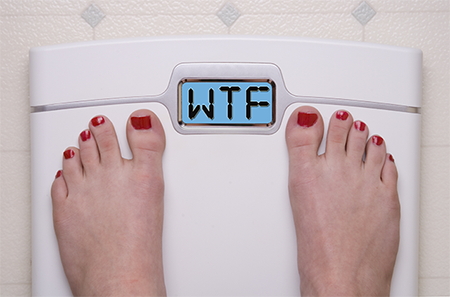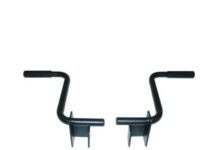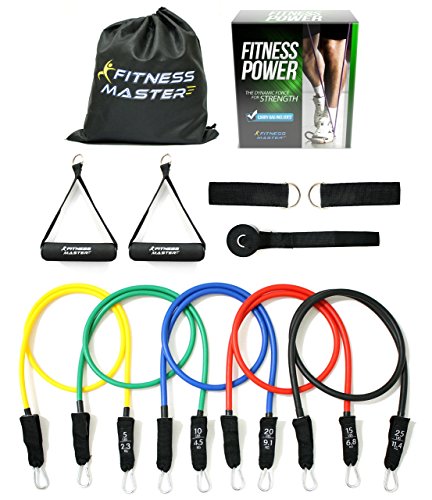Fat loss can be one of the most challenging and controversial fitness goals that a woman can set for herself. Especially women who are already relatively lean, for whom losing a little bit more fat can be particularly challenging.
While the desire to achieve a certain fat loss goal isn’t necessarily unhealthy, many women turn to unhealthy methods to promote quick fat loss when the typical healthy approach to diet and exercise doesn’t seem to be working anymore. These risky choices include very low calorie diets, excessive exercise (especially cardio), and potentially dangerous supplements.
There’s got to be a better way to get leaner without harming yourself… right?
If you’ve been working out and eating well for months and your progress has stalled, here are a few ideas for busting through that plateau in a healthy way—no crash dieting required.

Register for the Women’s Strength and Empowerment Weekend!
Spots are going fast, and it always sells out!
Count Your Calories
Before you panic over the idea of tracking your food intake, hear me out.
Getting clear, objective data about your dietary intake can help you identify any reasons why your current diet isn’t leading to fat loss.
One obvious issue could be that you may simply be eating too much. If you’ve already lost any significant amount of weight over time, your overall calorie needs have changed, and it’s possible that you’re now eating at a maintenance level, even though the same amount previously resulted in weight loss.
Or perhaps you’ve been working toward an intuitive eating approach, eating whenever you feel hungry. You might feel great, but that approach often supports a maintenance calorie intake, which will prevent you from tapping into stored body fat for energy.
Ultimately, though other factors can also affect fat loss, calories do count. You can’t eat more calories than you’re burning and expect to lose body fat.
 Check in on your diet and see if your intake might be a little higher than you need it to be, and adjust as necessary. Reducing your food intake by as little as 200-300 calories per day could be the difference between maintaining and losing weight. Generally a deficit of around 300-500 calories per days should be enough to allow for healthy fat loss. Here’s a great calculator to figure out your needs.
Check in on your diet and see if your intake might be a little higher than you need it to be, and adjust as necessary. Reducing your food intake by as little as 200-300 calories per day could be the difference between maintaining and losing weight. Generally a deficit of around 300-500 calories per days should be enough to allow for healthy fat loss. Here’s a great calculator to figure out your needs.
Remember: calorie counting doesn’t just help prevent overeating. It’s also useful for preventing undereating. Not only can undereating be just as problematic for fat loss, it can be especially harmful to your health.
Some women think that if a 500-calorie deficit is effective, then a deficit of 1000+ calories must be twice as effective. Unfortunately, this isn’t the case, and undereating can cause some serious health issues, not to mention a drop in metabolic rate, hormone health, and athletic performance.
Undereating is just as likely to cause a stall in fat loss as overeating, thanks to its effects on stress hormones, thyroid function, your energy expenditure from activity, and your metabolic rate. For women whose fat loss has stalled due to too large of a calorie deficit for too long, eating to maintenance levels (i.e. “re-feeding”) for a few months can actually help normalize your metabolic rate and hormones, give you the energy to be more active and allow for fat loss down the road when the body is no longer in a stressed state.
The information in this article can help you identify unhealthy undereating and offers some steps you can take toward recovering from it. If tracking your diet just really stresses you out, or you have a history of disordered eating, seek supervision by a professional if you’re going to do it.
Adjust Your Macros
“Macros” are macronutrients that provide the majority of our calories. They include protein, carbohydrate, and fat. (Alcohol is technically a macronutrient, but not one I recommend including as a significant portion of your diet!)
Changing up your macronutrient percentages can be a great way to make diet changes without actually changing your calorie intake, and can also help break through fat loss plateaus.
 High-protein diets have been shown time and again to be the most effective for weight loss, regardless of the carbohydrate or fat content of the diet. While eating at a calorie deficit, consuming a diet rich in high-quality protein, particularly animal protein, helps minimize the loss of muscle while allowing for fat loss.1,2,3,4
High-protein diets have been shown time and again to be the most effective for weight loss, regardless of the carbohydrate or fat content of the diet. While eating at a calorie deficit, consuming a diet rich in high-quality protein, particularly animal protein, helps minimize the loss of muscle while allowing for fat loss.1,2,3,4
Aim to get about 25 to 35 percent of your calories from protein, or around 0.8 to 1 gram per pound of body weight, to get the best results. As an example, a 140-pound woman might eat between 110 and 140 grams per day, which would be 24 to 31 percent of an 1800-calorie diet.
You can also adjust your carb or fat intake, depending on what your current diet is and how your body responds to reducing or increasing one of these macronutrients.
With my own clients, I’ve found that some people lose fat better on a lower carb diet, others while lose it better on a lower fat diet. The younger female clients who work out intensely seem to do best on a higher carbohydrate intake, whereas the older ones who are not as active tend to do better with a lower carbohydrate intake. Some of them stall in their progress on a low carb diet, and they start making progress again when they shift their diet to a higher carb/reduced fat intake, without a significant change to the total calorie intake.
If you’ve been on a very low carb or very low fat diet for a while, experiment with increasing whatever you’ve been avoiding while decreasing what you’ve been eating a lot of. An example would be shifting from a diet that provides about 20 percent of your calories from carbohydrate to one that provides 40 to 50 percent from carbs while lowering your fat intake. Or you could try bumping your fat up to deliver 40 to 50 percent of your total calories while dropping your carbs instead.
Remember: neither macronutrient is “bad” and neither should be avoided completely. There is a wide range of carb and fat intake levels that can support good health and sustainable fat loss. Every person is different, and you should be willing to experiment to find your ideal carb and fat balance.
Move More (And Move Smarter)
While the “eat less, move more” recommendation for fat loss isn’t very helpful for most women, there’s something to be said for incorporating intelligent training into your fat loss approach.
The easiest thing for most women to do is simply to move more throughout the day, such as walking and standing more than sitting. This can be done by adding a 20 to 30-minute walk at lunch, switching to a standing desk at work, or walking around the field at your kid’s soccer game. Adding a couple thousand extra steps to your day could help nudge your body to get fat loss going again.

Any effective fat loss approach generally includes higher intensity training a few times a week. This could be something as simple as a four-minute “Tabata” style sprint workout where you are working for 20 seconds, resting for 10 seconds and repeating that interval eight times, or you could try a 30 seconds on/30 seconds off approach and for 10-15 minutes. You can add high-intensity intervals (HIIT) like the ones listed above at the end of a strength workout or do them separately throughout the week.
Your options for HIIT are endless but some popular forms of cardio include using machines like an Airdyne bike or rower, doing bodyweight movements like burpees or air squats, or running sprints on a track. Here’s a great 15-minute bodyweight HIIT workout to try.
And if you’re not challenging yourself with heavier weights as part of a regular strength training routine, your fat loss progress may stall.
Heavy weight lifting, in addition to helping you get strong, is a fantastic and indispensable tool to have in your fat loss toolbox for a variety of reasons. Building muscle changes your physique even if your weight doesn’t change. Plus an increase in muscle boosts your overall your metabolic rate, meaning you can eat more and still get lean thanks to a higher calorie output. Strength training also prevents the loss of muscle when you’re in a calorie deficit, especially if you’re eating lots of protein.
Assuming you’re already doing strength training, make sure you’re challenging yourself to increase the weights you use. If you’re using dumbbells try heavier ones, or try barbells. If you’re already using barbells, try increasing weights you’re lifting by five to 10 pounds every few weeks. Here’s a great article that explains how to strength train for fat loss.
Assess Your Lifestyle
Diet and exercise are the primary factors that can affect your progress, but there are other lifestyle issues that can stall fat loss if they’re not attended to.
Sleeping at least seven to nine hours per night is crucial when you’re trying to lose fat, especially if you’re training hard multiple days per week. Research shows that sleep loss can increase your risk of weight gain, and can lead to undesirable changes in your metabolic function including insulin resistance and high cortisol, both which make fat loss extremely difficult.5,6,7
Speaking of high cortisol, you may be aware that cortisol is one of your body’s primary stress hormones. While having cortisol spikes during a tough workout can help promote fat loss, chronically high or low cortisol due to poor stress management contributes to increased fat storage, particularly around the midsection.
Even if your diet and exercise approach is on point, you absolutely need to get your sleep and stress habits lined up in order to continue losing body fat in a healthy way.
Set a consistent bedtime and make sure that you get at least seven hours of sleep or more each night. Modify your workout if you’re dealing with excessive stress or adrenal issues. To help manage stress better, try adding some yoga or meditation into your daily or weekly routine; here are three different types of yoga to complement your strength routine. Practice deep breathing exercises to keep your body calm when you’re feeling overwhelmed during the day.
A Few More Tips
While it’s tempting to make a lot of changes at once, remember that you’ll be more successful if you pick no more than one or two major changes discussed in this article and focus on being consistent with those first. Stay the course for a few weeks, then reassess your progress.
You can adjust your diet or your training regimen first, depending on what’s easiest for you or what needs the most work. For example, if your training schedule is packed full, rather than add more exercise, start by assessing your diet and see if you can make changes there without adjusting your workout routine.
 It bears repeating: Don’t minimize the impact that stress and sleep have on your health and fat loss efforts. It’s not all about calories in and out when it comes to weight loss. Sleeping well and reducing your stress will improve your body’s ability to recover from exercise, prevent emotional overeating, and improve your hormonal profile, all of which will make fat loss easier.
It bears repeating: Don’t minimize the impact that stress and sleep have on your health and fat loss efforts. It’s not all about calories in and out when it comes to weight loss. Sleeping well and reducing your stress will improve your body’s ability to recover from exercise, prevent emotional overeating, and improve your hormonal profile, all of which will make fat loss easier.
Pay attention to negative self-talk throughout the process. Constant self-criticism is a stressor, and the first step is to become aware of the way you speak about your body. If you’re constantly berating yourself about the way you look, it’s crucial to work on changing how you think about yourself. There’s no evidence that self-critique is a good motivator, and negative self-talk can actually harm long-term success thanks to the stress it causes.8
One of the best ways to eliminate negative self-talk is to practice gratitude. Think about how grateful you are for how your body functions, for the progress you’ve made so far, for the positive habits you are doing already, and more. Take a break from social media (or at least reassess your use of it) if you find yourself regularly falling into the comparison trap.
Know Your “Why”
Finally, one of the most important things to remember is that you need to be objective about your fat loss goals. While fat loss isn’t a bad goal to have, it can cause a lot of damage to your health if your goals are unrealistic or potentially unsafe.
Ask yourself: Is losing more body fat healthy for me? Is it safe? It’s possible that your body fat is at a healthy level already and going lower could actually lead to health problems.
Whether or not your body could physically handle some more fat loss, you also need to ask yourself why you want to lose more body fat.
How would getting leaner change or improve your life? Is the effort it would take to lose that body fat worth the sacrifice of time, energy, and enjoyment of food (or life in general?) Get clear about your values and why losing more fat is important (if it even is!) before you start putting in tons of effort towards reaching this goal.
Many women falsely believe that if they could only lose those last ___ pounds, that they’d finally be happy. They think that if they lose a little bit of body fat, they might feel more confident on dates, or finally take that beach vacation, or have more sex with their partner (or enjoy it more), or for once not dread going clothes shopping. So many women put their lives on hold to focus intently on their fat loss goals. But is it truly your body fat that’s holding you back from living a confident, joyful life?
As one of my favorite Girls Gone Strong, Neghar Fonooni, says:
“What if, instead of wondering how it would feel to be good, worthy, and deserving enough… you already knew? What if you truly believed that losing a few more pounds or squeezing into a smaller size dress had nothing to do with how amazing, powerful, and valuable you are?”
And while there’s nothing inherently wrong with wanting to get leaner, most women find that their happiness isn’t strongly affected by their body fat percentage or weight. Cultivating joy in the present, no matter what your body looks like, is ultimately much more satisfying than putting life on hold while you break yourself down pursuing a specific body fat percentage.
Save $200! Early bird price for the Women’s Strength & Empowerment Weekend ends soon!
The Women’s Strength and Empowerment Weekend, powered by Girls Gone Strong, was designed to create a space for women to rise, teach, lead, learn, and connect with one another. Throughout the weekend you’ll hear from some of the most well-respected women in the world from every facet of the health and wellness industry, from PhDs to Registered Dietitians to top CrossFit athletes, and pre and postnatal fitness and body autonomy experts.

You’ll be surrounded by a group of like-minded, strong women who are there to lift each other up, and help each other become the best version of themselves in a warm, welcoming, and inclusive environment.
You will leave the weekend feeling heard, loved, supported, and empowered and most importantly knowing that you have finally found your tribe.
Last year we sold out in just 26 hours, so if you’re interested in attending, click the button below.
References
- Ebbeling CB, Swain JF, Feldman HA, Wong WW, Hachey DL, Garcia-Lago E, Ludwig DS. Effects of dietary composition on energy expenditure during weight-loss maintenance. Journal of the American Medical Association (2012) 307(24):2627-34
https://www.ncbi.nlm.nih.gov/pmc/articles/PMC3564212/ - Astrup A, Raben A, Geiker N. The role of higher protein diets in weight control and obesity-related comorbidities. International Journal of Obesity (2015) 39: 721–726
http://www.nature.com/ijo/journal/v39/n5/full/ijo2014216a.html - Longland TM, Oikawa SY, Mitchel CJ, Devries MC, Phillips SM. Higher compared with lower dietary protein during an energy deficit combined with intense exercise promotes greater lean mass gain and fat mass loss: a randomized trial. The American Journal of Clinical Nutrition (2016) 103(3): 738-746
http://ajcn.nutrition.org/content/103/3/738.full - Layman DK, Evans E, Baum JI, Seller J, Ericsson DJ, Boileau RA. Dietary Protein and Exercise Have Additive Effects on Body Composition during Weight Loss in Adult Women. The Journal Of Nutrition (2005) 135(8): 1903-1910
http://jn.nutrition.org/content/135/8/1903.long - Patel SR, Hu FB. Short sleep duration and weight gain: a systematic review. Obesity (Silver Spring). 2008; 16:643-53.
https://www.ncbi.nlm.nih.gov/pmc/articles/PMC2723045/ - Patel SR, Malhotra A, White DP, Gottlieb DJ, Hu FB. Association between reduced sleep and weight gain in women. American Journal of Epidemiology 2006; 164:947-54.
https://www.ncbi.nlm.nih.gov/pmc/articles/PMC3496783/ - Taveras EM, Gilliman MW, Pena MM, Redline S, Rifas Shiman SL. Chronic Sleep Curtailment and Adiposity. Pediatrics. 2014;133(6):1013-22.
http://pediatrics.aappublications.org/content/early/2014/05/14/peds.2013-3065 - Kross E, Bruehlman-Senecal E, Park J, Burson A, Dougherty A, Shablack H, Bremner R, Moser J, Ayduk O. Self-Talk as a Regulatory Mechanism: How You Do It Matters. Journal of Personality and Social Psychology 2014; 106(2): 304 –324
http://selfcontrol.psych.lsa.umich.edu/wp-content/uploads/2014/01/KrossJ_Pers_Soc_Psychol2014Self-talk_as_a_regulatory_mechanism_How_you_do_it_matters.pdf
The post How To Bust Through A Fat Loss Plateau appeared first on Girls Gone Strong.






